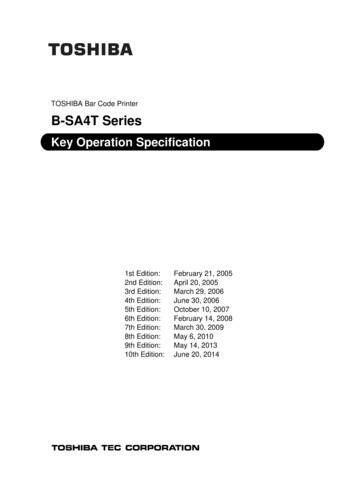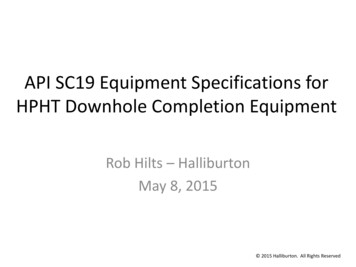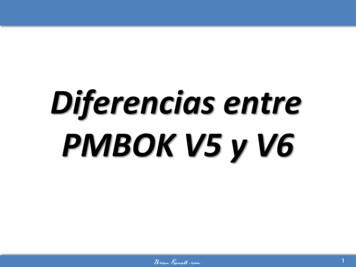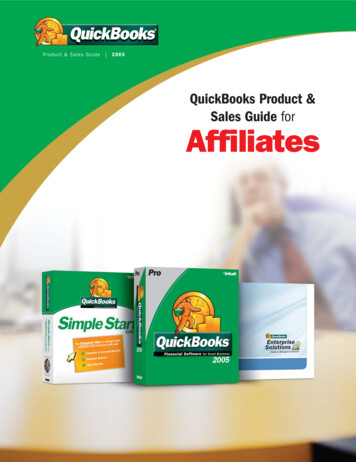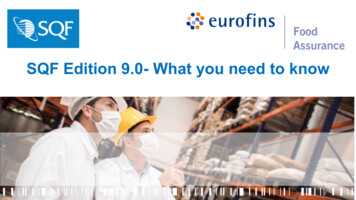
Transcription
SQF Edition 9.0- What you need to know
PresentersTammie Van BurenBrian Neal2
eurofins.com/foodassurance3
Eurofins SAFER@WORKTMThe Eurofins SAFER@WORK program is designed to help you toset up advanced risk management protocols to contribute to limitingthe impact of COVID-19 on your workplace.Eurofins SAFER@WORK program is designed and implemented byour experts in consulting, auditing and testing.4
Getting Certifiedwww.sqfi.com 5
Poll Question:Have you reviewed the key changes to SQF Edition 9 as itrelates to your area?6
SQF Codes, Edition 9- Implementation May 24th, 2021www.sqfi.com 7
Edition 8.1Edition 9FSC:FSC:FSC:Primary AnimalProductionPrimary PlantProductionAquaculture12, 3, 4, 56Animal mentsPet FoodAnimal Feed7, 8,910-22, 25, 33313234Storage andDistributionFood Packaging2627Quality CodeAny GFSIRecognizedStandardFood Retail (23)Foodservice (24)FundamentalsNo Changes Primary Codes divided into three different Codes. Pre-packing of produce (module 10) has beenremoved and is now with Primary Plant products. Processing of animal products, pet food andanimal feed have been removed from theManufacturing Code into separate Codes. No changes to Food Retail, Foodservice, orFundamentals Program.www.sqfi.com 8
Technical ChangesPart A Changed scoring from 10 points to 5points for a Major non-conformity. Modified requirement for unannouncedaudits to 1 unannounced audit every 3years. Removed requirement for desk audit forinitial certifications. Removed audit duration table and nowreference duration guide provided byGFSI. Included the option for remote auditactivities. Clarified activities when a site issuspended or fails an audit. Added IF/THEN table for easy reference.IFThe site does not permit there-certification or surveillanceaudit to occur within the auditwindow:THENThe certification body requests that within forty-eight (48) hours of receiving noticeof the suspension you provide a plan detailing the justification for the delay and thetimetable for the rescheduled audit (must be no more than thirty (30) days from theaudit window).The certification body conducts an announced onsite recertification or surveillanceaudit (as applicable) within thirty (30) calendar days of receiving your correctiveaction plan.If your site successfully completes the SQF audit with an E, G, or C rating, thecertification body reinstates your site status on the SQF assessment database andprovides you with written notice that your certificate is no longer suspended.Regardless of the rating and because the site failed to permit the recertificationaudit in the designated timeframe, the certification body conducts an additionalunannounced surveillance audit no more than six (6) months after the suspension toverify continued compliance with the SQF Code.The site does not take The certification body requests that within forty-eight (48) hours of receiving noticecorrective action within the of the suspension you provide a detailed plan outlining the corrective actions to betimeframe specified:taken to resolve the outstanding non-conformances.The certification body verifies that the corrective action plan has been implementedthrough an onsite visit within thirty (30) calendar days of receiving your correctiveaction plan.When the corrective action plan has been successfully implemented, thecertification body reinstates your site status on the SQF assessment database andprovides you with written notice that your certificate is no longer suspended.www.sqfi.com 9
Technical ChangesPart B There are numbering changes Some sections restructured for better flow Reduction of sections and clauses in codes/audit The word register is now referred to as List10
Technical ChangesPart BTop 9 for edition 91) Addition of Food Safety Culture in thepolicy statement and its own requirement.6) Additional requirement for adequateventilation.2) Clarified oversight of contractmanufacturers for high and low risk7) Added requirement for ambient airtesting for high-risk processes.3) New requirement for product changeoverand label reconciliation.8) Accommodate PC in Storage andDistribution and Feed Standards.4) Internal testing and sampling requirements.5) Additional training requirements as itpertains to testing and samplingrequirements,9) Additional requirements for water testingin Primary Produce Standard.www.sqfi.com 11
Edition 9 Key Changes:Primary PlantProduction GFSI additions in Primary PlantProducts – licensing & reviewprocess for plant/hybrids, HACCPbased model applied toPackhouses, “significant” incidentCAPA. Environment monitoring added forindoor ag & packhouses. GFSI – Chemical label compliance,visitor cross-contamination, wastesystem design. Water quality – CAFO add in forleafy greens. Commodity specific SOP’s forharvesting.www.sqfi.com 12
Edition 9 Key Changes:Animal FeedManufacturing HACCP based programs to includereference to preventive controls. Removed CIP reference Removed sensory evaluation. Removed Ice. 3.6.2 Cold Storage and thawingreference applicable toingredients not feed.www.sqfi.com 13
Edition 9 Key Changes:Pet FoodManufacturing Changed allergens to “IdentityPreserved Foods.” This betteridentifies the hazards to pets (i.e.grain free) and includes allergenrequirements (not mandatory).www.sqfi.com 14
Clarified language to food sector packaging.Edition 9 Key Changes:FoodPackaging Added requirement regarding quarantinedproduct. 2.4.5.2 Finished product returned from acustomer shall be quarantined untilauthorized for release for use or reshipment. Modified environmental monitoring to be lessprescriptive. Previously, the requirement waswritten to paper packaging. Clarified language around using othermaterials such as recycle material. 2.3.2.4 All raw materials including thosemade with recycled material, plant basedmaterial or additional additives, shall besuitable for the intended use, foodcontact compliance where applicable,and shall comply with the relevantlegislation in the country of manufactureand country of destination, if known.www.sqfi.com 15
Edition 9 Key Changes:Storage andDistribution Storage & Distribution followedfood manufacturing withcustomized language for DCs. HACCP based food safety planand includes reference topreventive controls. Added: 12.6.2.5 Procedures are inplace to identify the methods andresponsibilities used to ensure thatprocesses applied to materialsprior to distribution (e.g. thawing,slacking, labeling) do not pose arisk to product safety or loss oftraceability.www.sqfi.com 16
SQF System ElementsKey ChangesEdition 8.12.1 Management Commitment2.1.1 Food Safety Policy (Mandatory)2.1.2 Management Responsibility (Mandatory)2.1.3 Management Review (Mandatory)2.1.4 Complaint Management (Mandatory)2.1.5 Crisis Management PlanningEdition 92.1 Management Commitment2.1.1 Management Responsibility (Mandatory)2.1.2 Management Review (Mandatory)2.1.3 Complaint Management (Mandatory)2.2 Document Control and Records2.2.1 Food Safety Management System (Mandatory)2.2.2 Document Control (Mandatory)2.2.3 Records (Mandatory)Summary of changes: Combined, consolidated, and removed duplication of requirements. Clarified intent behind the requirement. Added food safety culture (2.1.1.1 and 2.1.1.2). Added requirement for substitute for SQF practitioner. Added requirement site is staffed and organized to meet food safety objectives. Moved Crisis Management Planning to 2.6.3 Recalls and Withdrawals. Removed 2.1.2.9 on continuous improvement.2.2 Document Control andRecords2.2.1 Food Safety Management System2.2.2 Document Control (Mandatory)2.2.3 Records (Mandatory)Summary of changes: Added requirement for retention periods to consider the shelf life of the product.www.sqfi.com 17
SQF System ElementsKey ChangesEdition 8.12.3 Specification and ProductDevelopment2.3.1 Product Development and Realization2.3.2 Raw and Packaging Materials2.3.3 Contract Service Providers2.3.4 Contract Manufactures2.3.5 Finished Product SpecificationsEdition 92.3 Specifications, Formulations,Realization and Supplier Approval2.3.1 Product Formulation and Realization2.3.2 Specifications (Raw Material, Packaging, FinishedProduct and Services)2.3.3 Contract Manufacturers2.3.4 Approved Supplier Program (Mandatory)Summary of Changes: Added detail regarding product formulations to include development by authorized persons and review when the there are changes in materials, ingredients, or equipment. Added process flow to 2.3.1.5. All specifications summarized under 2.3.2 and includes service providers. Added: suppliers to notify the site of changes in product composition that could have an impact on product formulation. Added Finished product labels shall be accurate, comply with the relevant legislation, and be approved by qualified company personnel. 2.3.2.4 has been split so that validation is retained in 2.3.2.4 and verification in 2.3.4.3. Co-manufacturers include high and low risk and third-party distributors. Approved supplier moved to 2.3.4 (formerly 2.4.4).2.4 Food Safety Systems2.4.1 Food Legislation (Mandatory)2.4.2 Good Manufacturing Practices (Mandatory)2.4.3 Food Safety Plan (Mandatory)2.4.4 Approved Supplier Program (Mandatory)2.4.5 Non-conforming Product or Equipment2.4.6 Product Rework2.4.7 Product Release2.4.8 Environmental Monitoring2.4 Food Safety System2.4.1 Food Legislation (Mandatory)2.4.2 Good Manufacturing Practices (Mandatory)2.4.3 Food Safety Plan (Mandatory)2.4.4 Product Sampling, Inspection, and Analysis2.4.5 Non-conforming Materials and Product2.4.6 Product Rework2.4.7 Product Release (Mandatory)2.4.8 Environmental MonitoringSummary of Changes: Product sampling now under 2.4.4 (formerly 2.5.4). 2.4.4.1 includes requirement on sampling and testing to be representative of the process batch to ensure process controls are maintained. Testing and analysis now includes reference to internal as well as external laboratories (internal lab formerly 11.8.1). Proficiency testing included in 2.4.4.2 (formerly 2.5.4.2). Non-conforming equipment moved to 11.1.7.9www.sqfi.com 18 Product release to include a procedure to confirm that product labels comply with the applicable food legislation Positive product release procedure in 2.4.7.3.
SQF System ElementsKey ChangesEdition 8.12.5 SQF System Verification2.5.1 Validation and Effectiveness (Mandatory)2.5.2 Verification Activities (Mandatory)2.5.3 Corrective and Preventative Actions(Mandatory)2.5.4 Product Sampling, Inspection andAnalysis2.5.5 Internal Audits and Inspections(Mandatory)Edition 92.5 SQF System Verification2.5.1 Validation and Effectiveness (Mandatory)2.5.2 Verification Activities (Mandatory)2.5.3 Corrective and Preventative Action(Mandatory)2.5.4 Internal Audits and Inspections (Mandatory)2.6 Product Traceability and CrisisManagement2.6.1 Product Identification (Mandatory)2.6.2 Product Trace (Mandatory)2.6.3 Product Withdrawal and Recall (Mandatory)2.6.4 Crisis Management PlanningSummary of Changes: Added detail to where deviations from food safety requirements may occur.2.6 Product Identification,Trace, Withdrawal and Recall2.6.1 Product Identification (Mandatory)2.6.2 Product Trace (Mandatory)2.6.3 Product Withdrawal and Recall(Mandatory)Summary of Changes: Added Crisis Management Planning to 2.6.4 (formerly 2.1.5). Emphasized labeling requirements and checks during operations to ensure that the correct product is in the correct package and with the correct label. Product changeovers to be inspected and approved by an authorized person. Procedures shall be implemented to ensure that label use is reconciled, and any inconsistencies investigated and resolved. Added requirements for testing the recall system to include products from different shifts and for materials across a range of products and customers.www.sqfi.com 19
SQF System ElementsKey ChangesEdition 8.12.7 Food Defense and FoodFraud2.7.1 Food Defense Plan (Mandatory)2.7.2 Food FraudEdition 92.7 Food Defense and Food Fraud2.7.1 Food Defense Plan (Mandatory)2.7.2 Food Fraud (Mandatory)2.8 Allergen Management2.8.1 Allergen Management (Mandatory)Summary of Changes: Consolidated to include all food defense and food fraud (from approved supplier)2.8 Allergen Management2.8.1 Allergen Management and FoodManufacturing (Mandatory)2.8.2 Allergen Management for Pet FoodManufacturing (Mandatory)2.8.3 Allergen Management for Manufacturers ofAnimal FeedSummary of Changes: Removed from allergen management the requirement to include labeling of gluten, where applicable. Added additional requirements regarding the approval, use, verification and reconciliations of labels.2.9 Training2.9.1 Training Requirements2.9.2 Training Program (Mandatory)2.9.3 Instructions2.9.4 HACCP Training Requirements2.9.6 Refresher Training2.9.7 Training Skills Register2.9 TrainingSummary of Changes: Training consolidated down to two sections - 2.9.1 Training Requirements and 2.9.2 Training Program. Added training requirements for the following tasks:-Sampling and test methods-Environmental monitoring for relevant staff.-Allergen management, food defense, and food fraud for all relevant staff.2.9.1 Training Requirements2.9.2 Training Program (Mandatory)www.sqfi.com 20
SQF Module 11Key ChangesEdition 8.111.1 Site Location and Construction11.1.1 Premises Location and ApprovalEdition 911.1 Site Location and Premises11.1.1 Premises Location and Approval11.1.2 Building Materials11.1.3 Lighting and Light Fittings11.1.4 Inspection/Quality Control Area11.1.5 Dust, Insect, and Pest Proofing11.1.6 Ventilation11.1.7 Equipment and Utensils11.1.8 Grounds and RoadwaysSummary of Changes: 11.1 Site Location and Premises now covers 11.1.2 Building Materials; 11.1.3 Lighting and Light Fittings; 11.1.4 Inspection/QC Area; 11.1.5 Dust, Insect, and Vermin Proofing; 11.1.6 Ventilation; 11.1.7Equipment and Utensils; and 11.1.8 Grounds and Roadways. Added a separate requirement for ventilation and positive air pressure. Equipment storage rooms moved to storage (11.6). 11.1.7.9 includes non-conforming equipment from (Formerly 2.4.5).11.2 Construction of11.2.1 Materials and Surfaces11.2 Site Operation11.2.1 Repairs and MaintenancePremises and Equipment 11.2.2 Floors, Drains and Waste Traps11.2.2 Maintenance Staff and Contractors11.2.3 Walls, Partitions, Doors and Ceilings.11.2.3 Calibration11.2.4 Stairs, Catwalks and Platforms11.2.4 Pest Prevention11.2.5 Lightings and Light Fittings.11.2.5 Cleaning and Sanitation11.2.6 Inspection/ Quality Control Area11.2.7 Dust, Insect and Pest Proofing11.2.8 Ventilation11.2.9 Equipment, Utensils and Protective Clothing11.2.10 Premises and Equipment Maintenance11.2.11 Calibration11.2.12 Pest Prevention11.2.13 Cleaning and SanitationSummary of Changes: 11.2 Site Operations. Includes 11.2.1 Repairs and Maintenance; 11.2.2 Maintenance Staff and Contractors; 11.2.3Calibration; 11.2.4 Pest Prevention; and 11.2.5 Cleaning and Sanitation. 11.2.2 Maintenance Staff and Contractors has been separated out from what was 11.2 Premises and Equipment Maintenance. Pest prevention restructured and clarified.www.sqfi.com 21 Handwashing basins changed to stations.
SQF Module 11Key ChangesEdition 8.111.3 Personnel Hygiene and Welfare11.3.1 Personnel11.3.2 Hand Washing11.3.3 clothing11.3.4 Jewelry and Personal Effects11.3.5 Visitors11.3.6 Staff Amenities11.3.7 Change Rooms11.3.8 Laundry11.3.9 Sanitary Facilities11.3.10 Lunch RoomsEdition 911.3 Personnel Hygiene and Welfare11.3.2 Handwashing11.3.3 Clothing and Personal Effects11.3.4 Visitors11.3.5 Staff Amenities (change rooms,toilets, break rooms)11.3.1 Personnel WelfareSummary of Changes: 11.3.2.5 Combined references to signage for handwashing. 11.3.3 Clothing and Personal Effects. (was “Clothing”) Includes laundering, protective clothing, and jewelry. 11.3.5 Staff Amenities includes change rooms, toilets, and break rooms.11.4 Personnel Processing Practices11.4.1 Staff Engaged in Food Handling andProcessing Operations11.4 Personnel Processing Practices11.4.1 Staff Engaged in Food Handling andProcessing OperationsSummary of Changes: Differentiated requirements for staff Personnel working in or visiting food handling areas. Process flow captured in 11.4.1.3 (from 11.7.1).www.sqfi.com 22
SQF Module 11Key ChangesEdition 8.111.5 Water, Ice and Air-Supply11.5.1 Water Supply11.5.2 Water Treatment11.5.3 Ice Supply11.5.4 The Quality of Air and Other GasesEdition 911.5 Water, Ice, and Air Supply11.5.1 Water Supply11.5.2 Water Treatment11.5.3 Water Quality11.5.4 Ice Supply11.5.5 Air and Other GasesSummary of Changes: 11.5.1.1: Added to water supply plan a requirement for contingency plans to be in place for instances when the potable water supply is deemed to be contaminated. 11.5.4.2 New clause in ice supply that ice is sourced from an approved supplier and included in the site's food safety risk assessment and to be supplied in appropriate containers.11.6 Storage and Transport11.6.1 Storage and Handling of Goods11.6 Receipt, Storage and Transport11.6.2 Cold Storage Freezing and Chilling ofFoods11.6.3 Storage of Dry Ingredients, Packaging,and Shelf Stable Packaged Goods11.6.4 Storage of Hazardous Chemicals andToxic Substances11.6.5 Loading, Transport and UnloadingPractices11.6.6 Loading11.6.7 Transport11.6.8 UnloadingSummary of Changes: 11.6.1.2: New clause to meet GFSI GMP 4.1 to ensure all materials are received and stored properly to prevent cross-contamination risks. 11.6.4: Storage of chemicals also applies to chemical storage references in 11.2.4 Pest Prevention. 11.6.5.4: New requirement for loading and unloading docks shall be designed to protect the product during loading and unloading.11.6.1 Receipt, Storage and Handling ofGoods11.6.2 Cold Storage, Freezing, and Chilling ofFoods11.6.3 Storage of Dry Ingredients, Packaging,and Shelf Stable Packaged Goods11.6.4 Storage of Hazardous Chemicals andToxic Substances11.6.5 Loading, Transport, and UnloadingPracticeswww.sqfi.com 23
SQF Module 11Key ChangesEdition 8.111.7 Separation of Functions11.7.1 Process Flow11.7.2 Receipt of Raw and PackagingMaterials and Ingredients11.7.3 Thawing of Food11.7.4 High Risk Processes11.7.5 Control of Foreign MatterContamination11.7.6 Detection of Foreign Objects11.7.7 Managing Foreign MatterContamination IncidentsEdition 911.7 Separation of Functions11.7.1 High-Risk Processes11.7.2 Thawing of Food11.7.3 Control of Foreign MatterContamination11.7.4 Detection of Foreign ObjectsSummary of Changes: 11.7.1.2 Ambient air in high risk areas shall be tested at least annually to confirm that it does not pose a risk to food safety. 11.7.3.11 New clause: “Gaskets, Rubber Impellers, and other equipment made of materials that can wear or deteriorate over time shall be inspected on aregular frequency.” Receipt of raw materials moved to 11.6.111.8 On-site Laboratories11.8.1 Location11.8 Waste Disposal11.8.1 Dry and Liquid Waste Disposal11.9 Waste Disposal11.9.1 Dry and Liquid Waste DisposalSummary of Changes: On-site laboratories moved to 2.4.4. 11.8.1.3 Moved from 11.2.9.5 in ed 8. “Waste and overflow water from tubs, tanks and other equipment shall be discharged direct to the floor drainage systemand meet local regulatory requirements.” 11.8.1.10 New clause to meet GFSI GMP 12.1 regarding the effective removal and storage (if required) of waste water.www.sqfi.com 24
Most Frequently Commented CodeRequirements2.1.1.2 Food Safety Culture was the most frequently commented on. Biggest concern was how the auditor will audit against it.11.5.5.3 Ambient air testing required for all sites. Feedback to why would it apply to all sites? Resulted in change to move it to HighRisk – NEW 11.7.1.2.2.3.3.3 Contract Manufacturers for third party storage and distribution business. Clarification regarding the use of other GFSI benchmarked standards and how itshould apply.2.4.4.2 Requirement for internal laboratories used for product analysis, samplingand testing methods shall be in accordance with 17025. GFSI mandated requirement and can’t be removed but based on publiccomment specific guidance or tip sheet will be developed2.6.1.2 Requirements for label reconciliation. Comments regarding how and where additional checks for label would apply.www.sqfi.com 25
2.1.1.2 Senior site management shall lead andsupport a food safety culture within the site thatensures at a minimum:i.The establishment, documentation, andcommunication to all relevant staff of foodsafety objectives and performancemeasures;ii.Adequate resources are available to meetfood safety objectives;Edition 9 Key Changes:Food SafetyCultureiii. Food safety practices and all applicablerequirements of the SQF System areadopted and maintained;iv. Staff are informed and held accountablefor their food safety and regulatoryresponsibilities;v.Staff are positively encouraged andrequired to notify management of actual orpotential food safety issues; andvi. Staff are empowered to act to resolve foodsafety issues within their scope of work.www.sqfi.com 26
Food Safety CultureRecords FS Objectives &Performances Measures Organization Chart Capital Project Plan Internal Audit Reports GMP Audit Reports Recognition Programs Disciplinary Process FS/Q Records Training Records Job DescriptionsInterviews Are you meeting your FSobjectives? How do youknow? Do you ever need help toget everything done? Who isyour back-up? Would you feel safe feedingyour product to your family? What happens if someoneviolates FS procedures? Explain a time when you toldmanagement about a FSissue. What was theresponse?Observations Is the companytransparent withperformance info? Do people appearrushed? Are they completingtasks above the minimumrequirements? Do employees seemhesitant to answerquestions? Do you see personnelpick up trash off the flooror do they walk by it?www.sqfi.com 27
Edition 9 Key Changes:InternalLaboratories2.4.4.2 Product analyses shall be conductedto nationally recognized methods orcompany requirements, or alternativemethods which are validated as equivalentto the nationally recognized methods.Where internal laboratories are used toconduct input, environmental or productanalysis, sampling and testing methods shallbe in accordance with the applicablerequirements of ISO/IEC 17025, includingannual proficiency testing for staffconducting analyses.External laboratories shall be accredited toISO/IEC 17025 or equivalent internationalstandard and included on the site’s contractservice specifications list (refer 2.3.2.11).www.sqfi.com 28
Proficiency TestingNew definition for edition 9.0:Proficiency testing is done via interlaboratory comparisons and calibrates the performance of laboratory personneland in-process testers, who conduct microbiological, chemical, or physical analyses of ingredients, materials, workin-progress, finished products and the processing environment.Proficiency testing IS NOT:Proficiency testing IS:TrainingCalibrationIntra-laboratory comparisonInter-laboratory comparisonFor product quality testing (or sensory)For food safety testing (product or environmental)Conducted for testing sent to a 3rd partyConducted for testing completed on-sitewww.sqfi.com 29
Implementation BestPractices Complete a gap analysis to identify changes needed Use the corrective action register and road map to guide changes necessaryfor compliance Complete a formal internal audit to verify compliance of completed changes Document SQF practitioner meetings with management on a standardizedagenda with meeting minutes Cascade SQF sponsorship from top management throughout the organizationwith the SQF practitioners as champions of the process as part of the foodsafety culture Use a third party to help with or verify compliance Celebrate success! Be fully prepared before May 2021www.sqfi.com 30
Where to go?If you would like further information:Brian NealBrianNeal@EurofinsUS.comTammie Van BurenCompliance@SQFI.comSQFI de-edition-9-downloads/31
How can we help? Consulting Services Pre-Assessment Services Auditing Services SQF Code Edition 9.0 Training Food Safety Culture Training Much more32
Poll Question:Would you like someone to contact you?33
Eurofins AssuranceFOR MORE INFORMATION, PLEASE nce/food34
2.7.2 Food Fraud: 2.7 Food Defense and Food Fraud. 2.7.1 Food Defense Plan (Mandatory) 2.7.2 Food Fraud (Mandatory) Summary of Changes: Consolidated to include all food defense a






